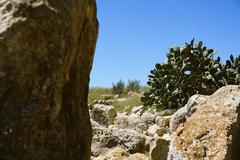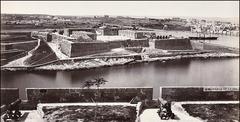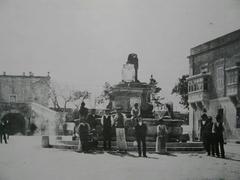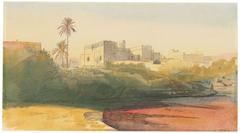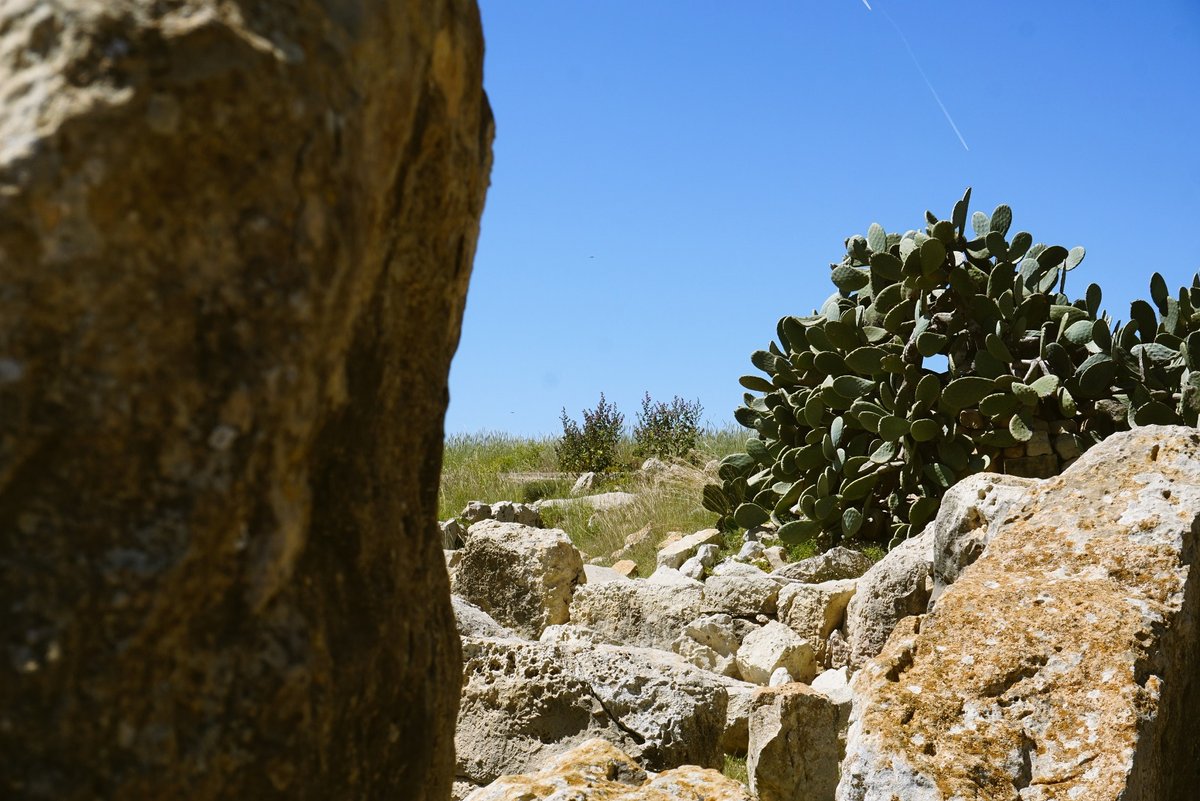
Visiting Borġ in-Nadur Megalithic Temple in Gżira, Malta: A Comprehensive Guide
Date: 23/07/2024
Introduction
Nestled in the heart of Gżira, Malta, the Borġ in-Nadur megalithic temple complex stands as a testament to the island’s rich prehistoric heritage. This ancient site, dating back to around 2500 BCE, provides a fascinating glimpse into the advanced architectural knowledge and cultural practices of Malta’s early inhabitants (Heritage Malta). As part of a network of megalithic temples across Malta and Gozo, Borġ in-Nadur is among the oldest free-standing structures globally, showcasing the ingenuity of a sophisticated society (UNESCO). This guide aims to offer a comprehensive overview of Borġ in-Nadur’s historical significance, architectural features, and practical visitor information, ensuring you have all the details for a memorable visit. Whether you are a history enthusiast, a casual traveler, or a photography aficionado, Borġ in-Nadur promises an enriching experience that connects you with Malta’s ancient past.
Table of Contents
- [Introduction](#introductionintroduction)
- [History of Borġ in-Nadur Megalithic Temple](#history-of-borġ-in-nadur-megalithic-templehistory-of-borg-in-nadur-megalithic-temple)
- [Prehistoric Origins](#prehistoric-originsprehistoric-origins)
- [Architectural Features](#architectural-featuresarchitectural-features)
- [Cultural Significance](#cultural-significancecultural-significance)
- [Bronze Age Transition](#bronze-age-transitionbronze-age-transition)
- [Excavations and Discoveries](#excavations-and-discoveriesexcavations-and-discoveries)
- [Preservation Efforts](#preservation-effortspreservation-efforts)
- [Modern Interpretations](#modern-interpretationsmodern-interpretations)
- [Comparative Analysis](#comparative-analysiscomparative-analysis)
- [Visitor Information](#visitor-informationvisitor-information)
- [Visiting Hours and Tickets](#visiting-hours-and-ticketsvisiting-hours-and-tickets)
- [Travel Tips and Accessibility](#travel-tips-and-accessibilitytravel-tips-and-accessibility)
- [Nearby Attractions](#nearby-attractionsnearby-attractions)
- [Special Events and Guided Tours](#special-events-and-guided-toursspecial-events-and-guided-tours)
- [Photographic Spots](#photographic-spotsphotographic-spots)
- [Frequently Asked Questions (FAQ)](#frequently-asked-questions-faqfaq)
- [Conclusion](#conclusionconclusion)
- [References](#referencesreferences)
History of Borġ in-Nadur Megalithic Temple
Prehistoric Origins
The Borġ in-Nadur megalithic temple complex, located in Gżira, Malta, dates back to the Neolithic period, around 2500 BCE. This era, known as the Temple Period in Maltese prehistory, saw the construction of monumental structures. Borġ in-Nadur is part of a network of megalithic temples across Malta and Gozo, among the oldest free-standing structures globally. These temples were built by a sophisticated society with advanced architectural knowledge (Heritage Malta).
Architectural Features
The Borġ in-Nadur temple complex is notable for its architectural uniqueness. It includes a four-apse structure, a common feature of Maltese megalithic temples. The apses, semi-circular recesses, likely served ritualistic purposes. The temple also has a large forecourt, suggesting communal gatherings and ceremonies took place here. This forecourt is flanked by massive stone blocks, some weighing several tons, showcasing the advanced engineering skills of the builders (UNESCO).
Cultural Significance
Borġ in-Nadur offers insights into the religious and social practices of Malta’s prehistoric inhabitants. The temples likely served as worship and ritual sites, possibly dedicated to a fertility goddess, indicated by numerous figurines and statues found on-site. These artifacts suggest a well-developed religious system valuing fertility and agricultural prosperity (Malta Tourism Authority).
Bronze Age Transition
Around 1500 BCE, the Borġ in-Nadur site saw significant changes with the advent of the Bronze Age. This period marked the decline of the temple-building culture and the emergence of new societal structures. The site was repurposed for defensive purposes, evident from the construction of a fortified wall around the complex. This wall, made of large stone blocks, indicates the inhabitants faced external threats and needed to protect their community (Malta Archaeological Review).
Excavations and Discoveries
Systematic excavations at Borġ in-Nadur began in the early 20th century, led by British archaeologist Margaret Murray. Her work uncovered numerous artifacts, including pottery, tools, and figurines, providing valuable insights into the daily lives and religious practices of the temple builders. Subsequent excavations have revealed new findings, such as evidence of animal sacrifices and complex burial practices, further enriching our understanding of the site (Murray, 1923).
Preservation Efforts
Preserving Borġ in-Nadur is a priority for Maltese authorities and international organizations. The site is protected under Maltese law and managed by Heritage Malta, responsible for cultural heritage. Preservation efforts include regular maintenance, controlled access to prevent damage, and educational programs to raise public awareness about its historical significance (Heritage Malta).
Modern Interpretations
Advancements in archaeological techniques and technologies have greatly enhanced modern interpretations of Borġ in-Nadur. Non-invasive methods such as ground-penetrating radar and 3D modeling allow researchers to explore the site without causing damage. These technologies have revealed previously unknown features, such as underground chambers and additional structures, providing a more comprehensive understanding of the temple complex (Journal of Archaeological Science).
Comparative Analysis
Borġ in-Nadur is often compared to other megalithic sites in Malta, such as Ħaġar Qim and Mnajdra. While each site has unique features, they share common architectural elements and cultural significance. Comparative studies show these temples were part of a broader cultural and religious network across the Maltese archipelago, helping researchers piece together Malta’s prehistoric past (Renfrew, 1973).
Visitor Information
Visiting Hours and Tickets
Borġ in-Nadur is open to visitors year-round. The visiting hours are typically from 9:00 AM to 5:00 PM, but it is advisable to check the official Heritage Malta website for the most up-to-date information. Tickets can be purchased on-site or online, with prices varying for adults, children, and seniors. Special discounts may be available for groups and students.
Travel Tips and Accessibility
The site is accessible by car, with parking available nearby. Public transportation options include buses that stop close to the site. The terrain can be uneven, so comfortable walking shoes are recommended. Accessibility for visitors with mobility issues is limited, and it is advisable to contact Heritage Malta in advance for assistance.
Nearby Attractions
While visiting Borġ in-Nadur, consider exploring nearby attractions such as the Tarxien Temples, the Hypogeum of Ħal-Saflieni, and the Marsaxlokk fishing village. These sites offer further insights into Malta’s rich historical and cultural heritage.
Special Events and Guided Tours
Heritage Malta occasionally organizes special events and guided tours at Borġ in-Nadur, providing deeper insights into the site’s history and significance. Check their website for upcoming events and tour schedules.
Photographic Spots
Borġ in-Nadur offers several picturesque spots perfect for photography enthusiasts. The forecourt and apses provide stunning backdrops, especially during the golden hours of sunrise and sunset.
Frequently Asked Questions (FAQ)
What are the visiting hours for Borġ in-Nadur?
The visiting hours are typically from 9:00 AM to 5:00 PM. For the most up-to-date information, check the official Heritage Malta website.
How much are the tickets to Borġ in-Nadur?
Ticket prices vary for adults, children, and seniors. Discounts may be available for groups and students. Tickets can be purchased on-site or online.
What are the best times to visit Borġ in-Nadur?
The best times to visit are early morning or late afternoon when the weather is cooler and the lighting is ideal for photography.
Conclusion
Exploring Borġ in-Nadur offers a unique glimpse into Malta’s prehistoric past. From its architectural marvels to its cultural significance, the site is a testament to the ingenuity and spiritual life of its ancient inhabitants. Plan your visit to this remarkable historical site and immerse yourself in the rich heritage of Malta. The transition from a ritualistic temple to a fortified Bronze Age settlement underscores the dynamic nature of its use and significance over millennia (Malta Archaeological Review). With ongoing preservation efforts and modern archaeological techniques, our understanding of Borġ in-Nadur continues to evolve, revealing new facets of this ancient marvel (Journal of Archaeological Science). Plan your visit today and explore the rich tapestry of history and culture that this exceptional site has to offer.
References
- Heritage Malta website https://heritagemalta.org
- UNESCO World Heritage List https://whc.unesco.org/en/list/132
- Malta Archaeological Review https://www.um.edu.mt/library/oar/handle/123456789/12345
- Journal of Archaeological Science https://www.sciencedirect.com/journal/journal-of-archaeological-science
